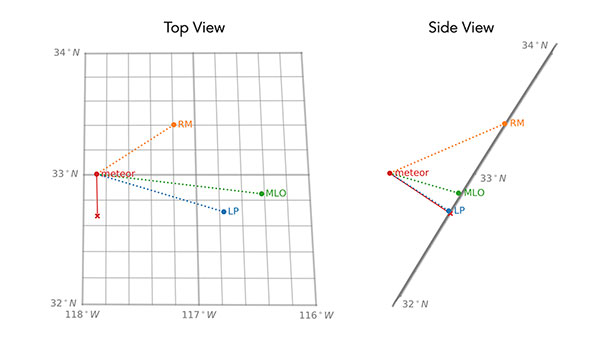Triangulating Meteors with HPWREN Cameras
By Robert Quimby, Director, Mount Laguna Observatory
Professor of Astronomy, San Diego State University
December 1, 2021
The HPWREN cameras often capture images of meteors streaking through the sky. A particularly good example was identified by Ross Seibert in one image from the west-facing camera at Lyons Peak the night of November 9. The first figure shows the bright violet trail of the meteor entering from the top of the frame as it plunged down to the Earth below.
Since HPWREN has many cameras spread over a large area, it is possible to triangulate the position of the meteor in the sky, although this is difficult in practice since meteors typically last only a fraction of a second and each HPWREN camera takes only one 1 second exposure each minute. Luckily in the case of Ross' meteor the south facing HPWREN camera at Red Mountain (RM) also caught a glimpse of the meteor trail, which is just barely visible through the marine layer of clouds obscuring the view above this lower elevation site. A third image of the meteor was captured by the all-sky camera at the Mount Laguna Observatory (MLO). Using the known positions of stars in these images it is possible to precisely determine the azimuth angle (compass bearing) and the angle above the horizon to the meteor in each image. Notice in the figure that the meteor is to the right of the four stars circled in red, but from Mount Laguna, which is 22 miles northeast of Lyons Peak (LP), the meteor passes between the two upper right stars. This is similar to how a thumb held at arm's length will shift left and right compared to distant objects as you close your left and right eyes, respectively. Using this "parallax" effect and the locations of the cameras on Earth, the distance to the meteor can be determined. The second figure shows the triangulation of the meteor's location.
The brightest part of the meteor trail occurred when the meteor was about 72 miles west of Lyons Peak at a height of about 35 miles over the Pacific Ocean. This section of the meteor trail alone is about 5 miles long. The full meteor trail is at least 20 miles long. Like other meteors, this one formed when a rock entered the atmosphere at a very high speed (tens of miles per second!), and friction rapidly stripped away its outer layers. As is commonly the case, it seems that the rock was vaporized before reaching the ground. Spread across tens of miles, that glowing vapor trail was bright enough to see a hundred miles away or more, but just for a second.

